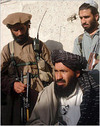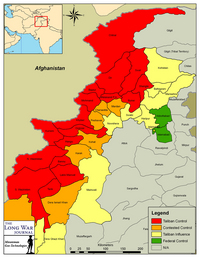The US conducted two separate airstrikes in Mullah Nazir’s territory in the Taliban-controlled tribal agency of South Waziristan. The strikes mark the second and third attacks in South Waziristan since Jun. 14 after a one-month hiatus in the Predator campaign.
Unmanned Predator strike aircraft hit a madrassa in the Shah Alam region of South Waziristan, and a training camp in the Raghzai region. Nine people have been reported killed in the two strikes. No senior al Qaeda or Taliban leaders have been reported killed or wounded at this time.
“Three missiles struck a training camp run by a local militant commander, Malang Wazir, in Raghzai,” an intelligence official told Dawn News. Both the camp in Raghzai and the madrassa in the Shah Alam “have been completely destroyed,” Geo News reported.
The regions where today’s strikes took place are run by Mullah Nazir, one of the two top Taliban commanders in South Waziristan. Nazir is a former rival and now ally of Pakistani Taliban leader Baitullah Mehsud. On Oct. 31, 2008, the US targeted Nazir and Tahir Yuldashev, the leader of the Islamic Movement of Uzbekistan, in a strike near Wana. Nazir was wounded in that attack. Yuldashev survived that attack, but is reported to have been wounded in a Pakistani Air Force airstrike in Baitullah’s home town of Makeen just two days ago.
Today’s Predator attacks are the second and third inside Pakistan since June 14. Prior to the June 14 Predator attack against Baitullah in Makeen, there had been a month-long lull since the US had last targeted Taliban or al Qaeda leaders or camps in Pakistan.
The US is set to exceed last year’s total of 36 airstrikes in Pakistan. Today’s strikes put this year’s total at 22.
South Waziristan is a major focus of the US air campaign against al Qaeda. Of the 22 strikes carried out in Pakistan this year, 14 of them took place in South Waziristan. Eight of this year’s attacks took place in Nazir’s territories; six took place in Baitullah’s tribal areas.
Several senior al Qaeda leaders have been killed in strikes in Nazir’s territories. This year, a Jan. 1 airstrike killed Osama al Kini, who is also known as Fahid Mohammed Ally Msalam, along with Sheikh Ahmed Salim Swedan. Al Kini was al Qaeda’s external operations chief and Swedan was al Kini’s senior aide. Both men were wanted for their involvement in the 1998 bombings at the US embassies in Kenya and Tanzania and have been implicated in other plots against the West and in Pakistan.
A July 28, 2008, strike killed Abu Khabab al Masri, a master bomb maker who was al Qaeda’s chief for its weapons of mass destruction program, and his senior staff. Among those killed with Abu Khabab were: Abu Mohammad Ibrahim bin Abi al Faraj al Masri, a religious leader; Abdul Wahhab al Masri; and Abu Islam al Masri.
No senior al Qaeda or Taliban leaders have been reported killed since the Jan.1 strike that killed al Kini and Swedan.
Nazir is one of three senior Taliban leaders in new alliance against the West
Nazir is often portrayed as a “pro-government Taliban leader” as he does not advocate attacking the Pakistani military or government and has battled Uzbek terrorists in his tribal areas. But his recent actions and his support for al Qaeda and the Afghan Taliban indicate that he indeed supports anti-state activities. And his battle with the Uzbeks was related to a tribal dispute and not due to opposition to the al Qaeda-linked group’s activities.
In February of this year, Nazir joined forces with senior Taliban leaders Hafiz Gul Bahadar and Baitullah Mehsud to form the Council of United Mujahideen. The three leaders said they “united according to the wishes of Mujahideen leaders like Mullah Muhammad Omar and Sheikh Osama bin Laden.”
The Council of United Mujahideen had pamphlets distributed throughout North and South Waziristan to announce its formation. The council threatened to strike at the US and other countries. The pamphlets also said the Taliban alliance “supported Mullah Muhammad Omar and Osama bin Laden’s struggle” against the administrations of US President Barack Obama, Pakistani President Asif Ali Zardari, and Afghan President Hamid Karzai.
The new alliance further stated it was waging war “in an organized manner'” to “stop the infidels from carrying out acts of barbarism against innocent people” just as Omar and bin Laden were waging war against Pakistan, Afghanistan, and the US.
Nazir has close ties to al Qaeda and maintains safe houses and training camps for the terror group. He recently granted an interview to As Sahab, al Qaeda’s propaganda arm, in which he blamed Pakistan for the Predator strikes and threatened to overrun the capital of Islamabad.
“All these attacks that have happened and are still happening are the work of Pakistan,” Nazir said. “The day is not far when Islamabad will be in the hands of the mujahedeen.” Nazir made it clear his forces were fighting alongside al Qaeda and the Afghan Taliban. Last December, Nazir began threatening to attack Pakistani security forces if the strikes did not stop.
Strike occurs as South Waziristan operation is in the opening stages
Today’s attack occurred as the Pakistani military is preparing to launch a new assault into South Waziristan. The military has been prepping the battlefield with air and artillery strikes, and has also closed off roads leading into Baitullah’s tribal areas.
Baitullah is the primary target of the South Waziristan operation. The military has singled out Baitullah and has not mentioned Nazir, Bahadar, or the powerful Haqqani family in its briefings. The government is negotiating with Nazir and Bahadar in an attempt to keep them on the sidelines and honor peace agreements that were made within the past two years.
It is still unclear if Bahadar and Nazir will sit out the fight. Bahadar sent hundreds of fighters to battle the Army as it moved into the Jani Khel and Baka Khel tribal areas in the Bannu district, which borders North Waziristan. Bahadar is said to have claimed the Army violated the terms of the peace agreement.
|
Click map for full view. Taliban presence, by district and tribal agency, in the Northwest Frontier Province, Punjab, and the Federally Administered Tribal Agencies. Information on Taliban presence obtained from open source and derived by The Long War Journal based on the presence of Taliban shadow governments, levels of fighting, and reports from the region. Map created by Bill Raymond for The Long War Journal. Last updated: April 24, 2009. |
Background on US strikes against al Qaeda and Taliban networks in northwestern Pakistan
US intelligence believes that al Qaeda has reconstituted its external operations network in Pakistan’s lawless, Taliban-controlled tribal areas. This network is tasked with hitting targets in the West, India, and elsewhere. The US has struck at these external cells using unmanned Predator aircraft and other means in an effort to disrupt al Qaeda’s external network and decapitate the leadership. The US has also targeted al Qaeda-linked Taliban fighters operating in Afghanistan, particularly the notorious Haqqani Network.
As of last summer, al Qaeda and the Taliban operated 157 known training camps in the tribal areas and the Northwest Frontier Province. Al Qaeda has been training terrorists holding Western passports to conduct attacks, US intelligence officials have told The Long War Journal. Some of the camps are devoted to training the Taliban’s military arm; some train suicide bombers for attacks in Pakistan and Afghanistan; some focus on training the various Kashmiri terror groups; some train al Qaeda operatives for attacks in the West; some train the Lashkar al Zil, al Qaeda’s Shadow Army; and one serves as a training ground for the Black Guard, the elite bodyguard for Osama bin Laden, Ayman al Zawahiri, and other senior al Qaeda leaders.
There were 36 recorded cross-border attacks and attempts in Pakistan during 2008, according to numbers compiled by The Long War Journal. Twenty-nine of those attacks took place after Aug. 31. There were only 10 recorded strikes in 2006 and 2007 combined.
During 2008, the US strikes inside Pakistan’s tribal areas killed five senior al Qaeda leaders. All of the leaders were involved in supporting al Qaeda’s external operations directed at the West.
Abu Laith al Libi, a senior military commander in Afghanistan, was killed in a strike in North Waziristan in January 2008.
Abu Sulayman Jazairi, al Qaeda’s external operations chief, was killed in a strike in Bajaur in March 2008.
Abu Khabab al Masri, al Qaeda’s weapons of mass destruction chief, and several senior members of his staff were killed in a strike in South Waziristan in July 2008.
Khalid Habib, the leader of al Qaeda’s paramilitary Shadow Army, was killed in a region controlled by Baitullah Mehsud in South Waziristan in October 2008.
Abu Jihad al Masri, the leader of the Egyptian Islamic Group and a member of al Qaeda’s top council, was killed in North Waziristan in October 2008.
In 2009, US strikes have killed two senior, long-time al Qaeda leaders. Osama al Kini and his senior aide, Sheikh Ahmed Salim Swedan, were killed in a New Year’s Day strike in South Waziristan. Kini was al Qaeda operations chief in Pakistan. Both men were behind the 1998 bombings of the US embassies in Dar es Salaam, Tanzania; and Nairobi, Kenya; which killed 224 civilians and wounded more than 5,000 others.
US attacks inside Pakistan during 2009:
• US strikes target Mullah Nazir in South Waziristan
June 18, 2009
• US kills five in South Waziristan strike
June 14, 2009
• US strikes Taliban, al Qaeda in North Waziristan
May 16, 2009
• US strikes again in South Waziristan
May 12, 2009
• US strike targets Baitullah Mehsud territory in South Waziristan
May 9, 2009
• US strike kills 10 Taliban in South Waziristan
April 29, 2009
• US airstrike targets Taliban training camp in South Waziristan
April 19, 2009
• US Predator kills four in South Waziristan strike
April 8, 2009
• US strikes Haqqani Network in North Waziristan
April 4, 2009
• US launches first strike in Arakzai tribal agency
April 1, 2009
• Latest US strike targets al Qaeda safe house in North Waziristan
March 26, 2009
• US airstrike kills 8 in Baitullah Mehsud’s hometown
March 25, 2009
• US launches second strike outside of Pakistan’s tribal areas
March 15, 2009
• US missile strike in Kurram agency kills 14
March 12, 2009
• US airstrike kills 8 in South Waziristan
March 1, 2009
• US airstrike in Pakistan’s Kurram tribal agency kills 30
Feb. 16, 2009
• US Predator strike in South Waziristan kills 25
Feb. 14, 2009
• US strikes al Qaeda in North and South Waziristan
Jan. 23, 2009
• US hits South Waziristan in second strike
Jan. 2, 2009
• US kills 4 al Qaeda operatives in South Waziristan strike
Jan. 1, 2009
For a summary of US strikes inside Pakistan in 2008, see US strikes in 2 villages in South Waziristan.










5 Comments
Bill: First paragraph text: ” The strikes mark the send and third attacks in South Waziristan since Jun 14 after a one-month hiatus in the Predator campaign. ” Correction: change the word “send” to “second”.
Thanks Nic, corrected.
FYI, I also had to adjust the totals, I miscounted…
There have been 22 strikes this year.
14 in South Waziristan.
8 against Nazir
6 against Baitullah.
I salute the americans for their bravery
When a madrrossa stops being a school, and starts being a facility used for storing arms, training terrorists, it becomes a target. There is no gray area.
The Thunder Run has linked to this post in the blog post From the Front: 06/19/2009 News and Personal dispatches from the front and the home front.